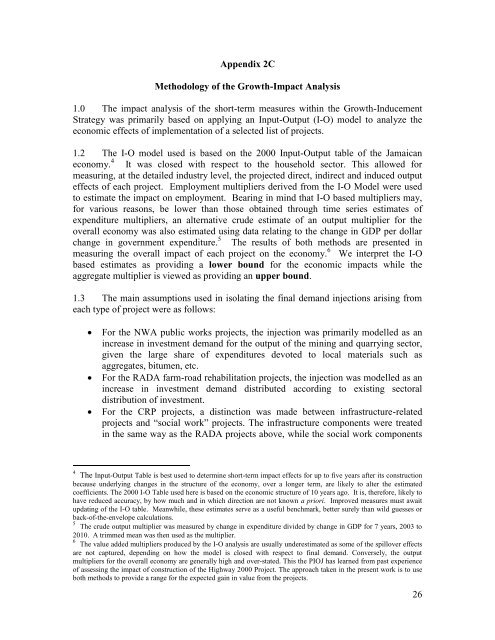PIOJ Growth-Inducement Strategy - Planning Institute of Jamaica
PIOJ Growth-Inducement Strategy - Planning Institute of Jamaica
PIOJ Growth-Inducement Strategy - Planning Institute of Jamaica
Create successful ePaper yourself
Turn your PDF publications into a flip-book with our unique Google optimized e-Paper software.
Appendix 2C<br />
Methodology <strong>of</strong> the <strong>Growth</strong>-Impact Analysis<br />
1.0 The impact analysis <strong>of</strong> the short-term measures within the <strong>Growth</strong>-<strong>Inducement</strong><br />
<strong>Strategy</strong> was primarily based on applying an Input-Output (I-O) model to analyze the<br />
economic effects <strong>of</strong> implementation <strong>of</strong> a selected list <strong>of</strong> projects.<br />
1.2 The I-O model used is based on the 2000 Input-Output table <strong>of</strong> the <strong>Jamaica</strong>n<br />
economy. 4 It was closed with respect to the household sector. This allowed for<br />
measuring, at the detailed industry level, the projected direct, indirect and induced output<br />
effects <strong>of</strong> each project. Employment multipliers derived from the I-O Model were used<br />
to estimate the impact on employment. Bearing in mind that I-O based multipliers may,<br />
for various reasons, be lower than those obtained through time series estimates <strong>of</strong><br />
expenditure multipliers, an alternative crude estimate <strong>of</strong> an output multiplier for the<br />
overall economy was also estimated using data relating to the change in GDP per dollar<br />
change in government expenditure. 5 The results <strong>of</strong> both methods are presented in<br />
measuring the overall impact <strong>of</strong> each project on the economy. 6 We interpret the I-O<br />
based estimates as providing a lower bound for the economic impacts while the<br />
aggregate multiplier is viewed as providing an upper bound.<br />
1.3 The main assumptions used in isolating the final demand injections arising from<br />
each type <strong>of</strong> project were as follows:<br />
<br />
<br />
<br />
For the NWA public works projects, the injection was primarily modelled as an<br />
increase in investment demand for the output <strong>of</strong> the mining and quarrying sector,<br />
given the large share <strong>of</strong> expenditures devoted to local materials such as<br />
aggregates, bitumen, etc.<br />
For the RADA farm-road rehabilitation projects, the injection was modelled as an<br />
increase in investment demand distributed according to existing sectoral<br />
distribution <strong>of</strong> investment.<br />
For the CRP projects, a distinction was made between infrastructure-related<br />
projects and “social work” projects. The infrastructure components were treated<br />
in the same way as the RADA projects above, while the social work components<br />
4 The Input-Output Table is best used to determine short-term impact effects for up to five years after its construction<br />
because underlying changes in the structure <strong>of</strong> the economy, over a longer term, are likely to alter the estimated<br />
coefficients. The 2000 I-O Table used here is based on the economic structure <strong>of</strong> 10 years ago. It is, therefore, likely to<br />
have reduced accuracy, by how much and in which direction are not known a priori. Improved measures must await<br />
updating <strong>of</strong> the I-O table. Meanwhile, these estimates serve as a useful benchmark, better surely than wild guesses or<br />
back-<strong>of</strong>-the-envelope calculations.<br />
5 The crude output multiplier was measured by change in expenditure divided by change in GDP for 7 years, 2003 to<br />
2010. A trimmed mean was then used as the multiplier.<br />
6 The value added multipliers produced by the I-O analysis are usually underestimated as some <strong>of</strong> the spillover effects<br />
are not captured, depending on how the model is closed with respect to final demand. Conversely, the output<br />
multipliers for the overall economy are generally high and over-stated. This the <strong>PIOJ</strong> has learned from past experience<br />
<strong>of</strong> assessing the impact <strong>of</strong> construction <strong>of</strong> the Highway 2000 Project. The approach taken in the present work is to use<br />
both methods to provide a range for the expected gain in value from the projects.<br />
26
















